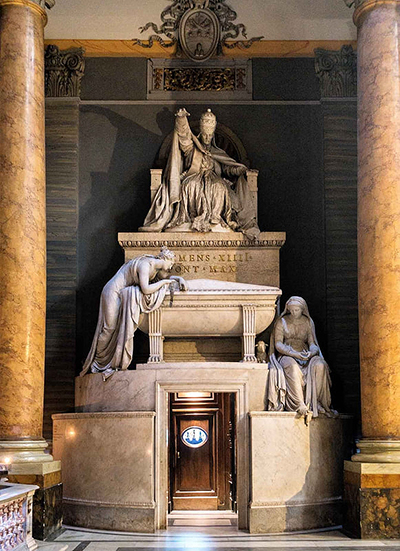The funerary monument of Clement XIV took around four years to complete, although its creator, Antonio Canova, would not have been working on it for all of that period. The Italian sculptor had a studio of assistants who were able to carry out requests on his behalf whilst he oversaw the direction of the project from afar.
Canova would use carrara marble and lumachella in order to complete this work, with the former being his preference for most of his career. He places Clement XIV directly at the top of the sculpture, with one arm outstretched, as he looks down on us all. The main subject of any tomb design would normally be positioned in this way, so as to make it clear as to who the overall design is referred to. Below him are two further figures who flank the two sides of this triangular shaped construction. Canova laid out the content in a similar way to how he also designed the Tomb of Pope Clement XIII which itself is located in St Peter's Basilica in Vatican City. Leading up to his work in the mid 1780s, Canova had completed Theseus on the Minotaur to a chorus of appreciation which then put his name in the mix for future Roman commissions, with this tomb following shortly after. Carlo Giorgi, a successful Italian merchant, felt he owed the Pope after receiving preferential treatment which enabled him to quickly develop his own business interests, leading to his decision to commission this project. The finished design stands at over seven metres tall.
This key Roman sculpture was installed within the Basilica of the Holy Apostles in Rome upon completion. The figure to the left is of the Temperance, who leans over the sarcophagus with an entirely sombre expression which feels entirely appropriate for the content involved. To the right hand side, sat upon the middle level is a figure who represents Humility. She bows her head in a similarly sad expression of grief, perhaps suggesting her own concern at the direction of humanity at that time. The overall balance of the design is said to have been fairly innovative at that time, moving in a different direction to how other sculptors had previously composed similar projects. Canova was well aware, and respectful of, other historic sculptors but he constantly sought out new innovative methods which became one of the key parts of his success. One can compare his achievements to the likes of Michelangelo, Bernini, Ghiberti and Donatello to see stylistic differences across their output.
Italian sculpture would undergo a number of changes and developments over the period from the Renaissance through to the Neoclassical era. Everything was up for discussion now, from the materials used to the ways in which the designs were composed. Artists would take what had gone before and append their own ideas, with the best managing to do so successfully. Italian provinces would compete to become the most respected artistic regions, and at the time they had much more autonomy as separate kingdoms than they do since the formation of the new Italy. The likes of Canova would therefore be in high demand, as just a few individuals would be seen as the solution to winner these culture wars that also spread into painting and architecture. This led to sculptors being called to different parts of what we now know as Italy, often working on different projects at the same time as commissions continued to flood in.




